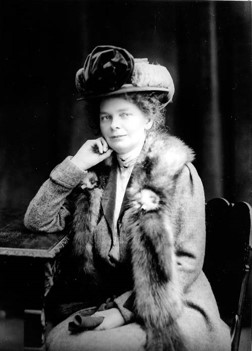Margaret and Kate

Margaret Stoddart c.1910 (Courtesy Canterbury Museum, Ref: S130 1/2)
In the late 1880s and 1890s, women’s place in society was a focus of debate. Garden Scene places Margaret Stoddart within a time and place of rapid change; a woman striving to be an artist, gaining an education and financial independence. The exhibition highlighted the connection between Stoddart and Kate Sheppard, who attended Canterbury College School of Fine Arts as students together. Stoddart’s response to the suffrage campaign (which Sheppard led from 1887) was recorded in private correspondence with her friend Rosa Dixon: “Have you been to register your vote yet? We are all flocking to do so here…” [1]
Conceivably Aotearoa’s foremost painter of indigenous flora, Stoddart became an important role model as a professional female artist. “Beginning in the 1880’s with precisely observed studies of native plants, she moved on to delicately painted still lifes and, by the early 1900s, her painterly techniques meant that she was well on the way to making this genre her own.” [2]
Born in 1865, in Diamond Harbour, Canterbury, Stoddart attended the Canterbury College School of Art from 1882-1890. There she became a founding member of the Palette Club, a group of artists committed to working from nature, and established her reputation as a leading flower painter. In 1885 she was elected to the council of the Canterbury Society of Arts and, over the following decade her status grew, regularly exhibiting and selling her paintings to institutions throughout Aotearoa.

Art class at Canterbury College (University of Canterbury School of Fine Arts records, MB 2114)
From 1897 Stoddart spent nine years living in Europe, travelling and living in England, France and Italy. During this time she undertook lessons, met like-minded creatives (including fellow expatriate artist Frances Hodgkins), and exhibited at esteemed galleries such as the Royal Institute in London, the Society of Aquarellists in Rome, and the Salon of the Société des Artistes Français and the Société Nationale des Beaux-Arts in Paris.
The artist returned to New Zealand in 1906, living with her sisters and mother in Diamond Harbour before moving to Christchurch in 1913. In the subsequent years Stoddart became a member of the Christchurch Sketch Club, vice president of the Canterbury Society of Arts and taught at the Canterbury College School of Art. Through her teaching she influenced a younger generation of artists including Rita Angus, Evelyn Page and Sir Toss Woollaston.
[1 ]Julie King, Flowers into Landscape, Robert McDougall Art Gallery: Hazard Press, Christchurch, 1997., p.34
[2] Ibid, p.14
Kate Sheppard

Kate Sheppard (Courtesy Alexander Turnbull Library, Ref: 1/2-C-09028; F)
Katherine ("Kate") Wilson was born in Liverpool England and arrived in New Zealand with her siblings and widowed mother in February 1869. The family settled in Christchurch, where in 1871 Katherine married Walter Allen Sheppard, a grocer and general merchant. Kate Sheppard was an active member of the Trinity Congregational Church and in 1885 became a founding member of the Women's Christian Temperance Union. She was soon to spearhead their campaign for New Zealand women obtaining the right to vote, which was eventually successful in September 1893. Much of the campaign focussed on gathering thousands of signatures on a petition demanding the vote. These petition sheets from around the country were assembled on the Sheppard's dining table in the house on Clyde Road.
